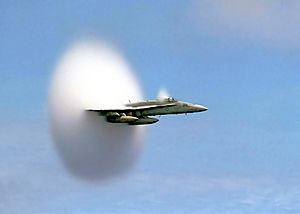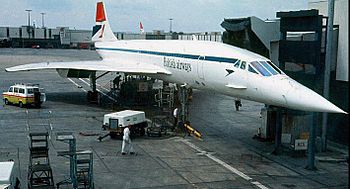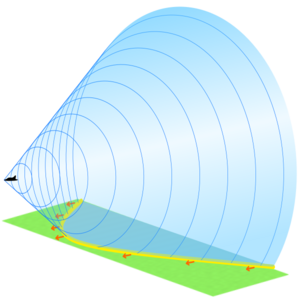Supersonic speed facts for kids

Supersonic speed is when an object moves faster than the speed of sound. Imagine a plane flying so fast that it leaves its own sound behind!
The speed of sound changes depending on where you are. In dry air at 20 °C (68 °F) near the ground, sound travels about 343.2 meters per second (767 miles per hour).
Scientists use something called the Mach scale to talk about these speeds:
- Mach 1 is exactly the speed of sound.
- Speeds greater than Mach 5 are called hypersonic.
- When only parts of an object, like a plane's wingtips, reach supersonic speeds, it's called transonic flight. This usually happens between Mach 0.8 and Mach 1.2.
Sound travels as vibrations or pressure waves through things like air or water. An object is supersonic when it moves faster than these sound waves can spread out. In gases, sound speed mostly depends on the gas's temperature. This means the speed of sound changes with altitude because the air temperature changes.
In water at room temperature, supersonic speed is anything faster than 1,440 meters per second (3,130 miles per hour). In solid materials, sound can travel even faster!
Contents
What "Supersonic" Used to Mean
At the start of the 1900s, "supersonic" meant sounds that were too high-pitched for humans to hear. Today, we call these sounds "ultrasonic".
The word "supersonic" comes from two Latin words:
- Super: meaning "above"
- Sonus: meaning "sound"
So, "supersonic" literally means "above sound" or "faster than sound."
Objects That Go Supersonic
You might be surprised by some everyday things that can go supersonic:
- Bullwhips: The tip of a bullwhip is thought to be the first man-made object to break the sound barrier. This creates the famous "crack" sound, which is actually a tiny sonic boom.
- Bullets: Most modern firearm bullets are supersonic. Rifle projectiles can often travel faster than Mach 3.
- Spacecraft: When spacecraft return to Earth, they are usually supersonic for part of their journey. However, the air is very thin high up, so the effects are less strong.
- Balloons: When an inflated balloon bursts, the pieces of rubber snap back at supersonic speed. This helps make the loud popping noise.
Remember, the speed of sound gets a bit slower as you go higher in the atmosphere, up to about 25 kilometers (15 miles). This is because the air gets colder.
Supersonic Land Vehicles
Only one land vehicle has officially traveled at supersonic speed: the ThrustSSC.
- The ThrustSSC holds the world land speed record. It was driven by Andy Green.
- On October 15, 1997, it reached an average speed of 1,228 kilometers per hour (763 miles per hour) in the Black Rock Desert.
The Bloodhound LSR project aimed to break this record.
- It planned to reach speeds up to 1,609 kilometers per hour (1,000 miles per hour).
- The project faced funding problems and was delayed due to the Covid-19 pandemic. The vehicle is now for sale.
Supersonic Flight
Most modern fighter aircraft can fly at supersonic speeds.
- For a while, there were also supersonic passenger planes like the Concorde and the Tupolev Tu-144.
- The Concorde flew supersonically more than all other aircraft combined! It made its last flight in 2003.
- Some large bombers, like the Tupolev Tu-160 and Rockwell B-1 Lancer, can also fly supersonically.
Designing supersonic aircraft is tricky.
- Planes need a lot more power to push through the air when they are flying in the transonic region (around Mach 0.85–1.2).
- Engineers use special design rules, like the Supersonic area rule, to make sure the plane's shape helps it move smoothly through the air without creating too many shock waves.
- To have low drag at supersonic speeds, aircraft are often designed to be very long and thin. This is why planes like the SR-71 and Concorde look so similar, with their slender bodies and large delta wings.
See also
 In Spanish: Velocidad supersónica para niños
In Spanish: Velocidad supersónica para niños





